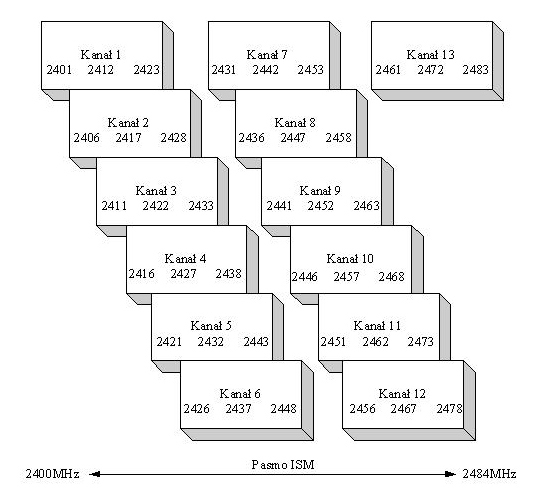In which standard do the wireless RGB Technology devices work?
- 802.11b - 11Mb/s standard using the frequency of 2.4 GHz has a range of 10 m indoors and 50 m outdoors; in practice you may reach transfers of approximately 5.5 Mb/s. Materials such as water, metal, or concrete reduce the signal quality; 802.11b standard is divided into 14 channels, each 22MHz wide, which partly overlap; Poland uses only 2400 to 2483.5 MFz bands - channels from 1 to 13;
What is the range of the wireless network?.
From several to several hundred meters, depending on the conditions.
Which factors influence the wireless network range?
You need to be aware that the wireless network range depends on many factors, some of which we can influence but others still remain unknown. The network range depends on:
1. The factors connected with the applied devices:
- power output of the device,
- antennas' gain,
- device sensitivity
2. External factors:
- attenuation between the antennas,
- interference of other devices (can't be predicted - you need to include some extra power supply to compensate for the interferences),
- impact of possible obstacles (walls, ceilings, trees, etc.)
Do atmospheric conditions influence the operation of wi-fi devices (attenuation in rain and gas)?
Although atmospheric conditions are commonly believed to be adverse for the operation of radio systems, they are practically harmless for WLAN 2.4GHz and 5GHz systems.
Radio channel selection for ad-hoc connections with the display.
2.4 GHz band consists of 13 channels, three of which are independent. It means that no more than three WLAN networks can work in a given place. Before the installer starts constructing the WLAN system, they should check if there are any radio channels available. If there are free resources, they should choose a radio channel of the lowest noise level.
The distribution of channels in 2.4 GHz band. Only three channels, out of 13, do not overlap: eg.: 1, 7, 13 or 1, 6, 11.
The conducted tests have proved that the influence of two networks operating in the same area depends on the selected channels and is all the smaller, the more distant the channels are from each other. When two networks operate in the same channel, each of them has only half of the bandwidth available. The most unfavourable situation is when the networks operate in the neighbouring channels, because they interact as if there were a high value noise, and they can use only about 20% of their possible bandwidth effectively. The interval of just four channels gives each network about 70% of its theoretical bandwidth. In practice, it is apparent that even theoretically independent channels have some influence on each other.














